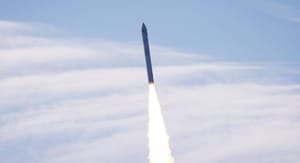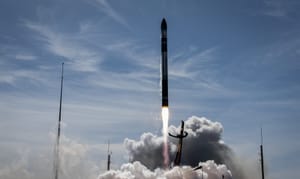
From SpaceX's Starbase launch site, near Boca Chica in south Texas, Starship-Super Heavy flew its sixth flight test at 22:00 pm Universal Coordinated Time. This flight test utilized Ship 31 and Super Heavy Booster 13.
In a first for the Starship program, a payload was onboard. This payload was a banana attached to the Starlink satellite deployment mechanism, doubling as a microgravity indicator too.
Liftoff of Starship! pic.twitter.com/rSLQ2DDy63
— SpaceX (@SpaceX) November 19, 2024
Liftoff of Starship-Super Heavy for the fifth flight test, via SpaceX on X.
Once again the Super Heavy booster lit all thirty-three Raptor engines, carrying the entire vehicle skyward. All engines remained running up until 'most engines cut-off'. With 'most engines cut-off', Ship 31 lit all six of its Raptor engines to hot-stage from the booster.
After Ship 31 hot-staged, Booster 13 began its boost back burn to head back towards the launch site. The boost back burn was performed as planned but safety criteria were not fulfilled for a return to the launch site. With the criteria unfulfilled, Booster 13 headed for the Gulf of Mexico instead, and successfully splashed down.
Super Heavy initiates its landing burn and softly splashes down in the Gulf of Mexico pic.twitter.com/BZ3Az4GssC
— SpaceX (@SpaceX) November 19, 2024
Super Heavy Booster 13 during its landing burn and splashdown, via SpaceX on X.
While the booster was splashing down, Ship 31 completed its ascent to a barely sub-orbital trajectory. This trajectory sent the vehicle to the targeted reentry site in the Indian Ocean.
While coasting towards atmospheric reentry, SpaceX performed its first in-space Raptor relight. This relight of a Raptor engine in the microgravity environment is a key technology milestone ahead of an orbital flight of Starship.
After coasting through space for a little over forty minutes, plasma began to build in front of Ship 31's heatshield for atmospheric reentry. During reentry, some of the steel on Ship 31 began to deform in areas where thermal protection tiles had been removed while debris were spotted falling away. A few burn-throughs were seen, but no structural failures are believed to have occurred.
Live views brought to you by @Starlink pic.twitter.com/QryeQ62yiP
— SpaceX (@SpaceX) November 19, 2024
Ship 31 during atmospheric reentry, via SpaceX on X.
Following atmospheric reentry Ship 31 emerged in daylight over the Indian Ocean. Not long after Ship 31 was traveling at sub-sonic speeds in a nose-down position to test stress limits on the vehicle.
Under a kilometer above the ocean surface, three Raptor engines relit for the 'flip-and-burn' maneuver. With the engines relit Ship 31 softly splashed down in the Indian Ocean, completing the sixth flight test.
Splashdown confirmed! Congratulations to the entire SpaceX team on an exciting sixth flight test of Starship! pic.twitter.com/bf98Va9qmL
— SpaceX (@SpaceX) November 19, 2024
Ship 31 splashing down in the Indian Ocean, via SpaceX on X.
Shortly after splashdown of Ship 31, Elon Musk, SpaceX's Chief Executive Officer, stated that Starship would perform one more ocean landing ahead of the first ship catch attempt, meaning the first catch of a ship could occur in early 2025. A few hours after the end of the sixth flight test, SpaceX also said the following on its website:
"The sixth flight test of Starship launched from Starbase on November 19, 2024, seeking to expand the envelope on ship and booster capabilities and get closer to bringing reuse of the entire system online."
"The Super Heavy booster successfully lifted off at the start of the launch window, with all 33 Raptor engines powering it and Starship off the pad from Starbase. Following a nominal ascent and stage separation, the booster successfully transitioned to its boostback burn to begin the return to launch site. During this phase, automated health checks of critical hardware on the launch and catch tower triggered an abort of the catch attempt. The booster then executed a pre-planned divert maneuver, performing a landing burn and soft splashdown in the Gulf of Mexico."
"Starship completed another successful ascent, placing it on the expected trajectory. The ship successfully reignited a single Raptor engine while in space, demonstrating the capabilities required to conduct a ship deorbit burn before starting fully orbital missions. With live views and telemetry being relayed by Starlink, the ship successfully made it through reentry and executed a flip, landing burn, and soft splashdown in the Indian Ocean."
"Data gathered from the multiple thermal protection experiments, as well as the successful flight through subsonic speeds at a more aggressive angle of attack, provides invaluable feedback on flight hardware performing in a flight environment as we aim for eventual ship return and catch."
"With data and flight learnings as our primary payload, Starship’s sixth flight test once again delivered. Lessons learned will directly make the entire Starship system more reliable as we close in on full and rapid reusability."
How does it compare to flight five?
On the last flight, Super Heavy Booster 12 lit all thirty-three of its Raptor engines successfully. All engines remained running up until 'most engines cut-off' for hot-staging, with Ship 30 lighting all six of its engines to head into space.
After hot-staging, Booster 12 relit ten of its engines to perform its boost back burn to head back to the launch site. Once the boost back burn was complete, Booster 12 separated the hot-staging ring and passed through its descent. Following descent Booster 12 lit all thirteen engines again, before going down to three, for the first successful Super Heavy Booster catch of SpaceX's Starship program!
Thousands of distinct vehicle and pad criteria had to be met prior to catching the Super Heavy booster. Thanks to the tireless work of SpaceX engineers, we succeeded with catch on our first attempt. pic.twitter.com/6wa5v6xHI0
— SpaceX (@SpaceX) October 13, 2024
Super Heavy Booster 12 during its landing burn and tower catch, via SpaceX on X.
While the booster was being caught back in Texas, Ship 30 was heading toward reentry over the Indian Ocean. Ship 30 passed through atmospheric reentry with only minor burn-throughs, retaining precise control throughout.
Following reentry Ship 30 kept accurate control during sub-sonic descent for a few minutes as planned. Once the vehicle was low enough three Raptor engines relit to perform the 'flip-and-burn' maneuver to successful splashdown in close proximity to SpaceX's pre-placed cameras.
Starship flip maneuver and landing burn on its fifth flight test. Vehicle improvements ensured flaps were protected from high heating, resulting in a controlled entry and high accuracy splashdown at the targeted area in the Indian Ocean pic.twitter.com/nLIQLLVMv1
— SpaceX (@SpaceX) October 18, 2024
Ship 30 during its 'flip-and-burn' to splashdown in the Indian Ocean, via SpaceX on X.
What is Starship-Super Heavy?
Starship-Super Heavy is SpaceX's in-development fully reusable super heavy-lift launch vehicle and the largest rocket currently flying. SpaceX is currently aiming to have the launch vehicle deliver one-hundred and fifty tons to low Earth orbit while reused or two-hundred and fifty tons when expended, although there are rumors from SpaceX of an expendable payload capacity of three-hundred tons.
On the launch pad, Starship-Super Heavy is one-hundred and twenty-one meters tall and weighs 5,000,000 kilograms fully fuelled. The diameter of both vehicles is nine meters, excluding aerodynamic control surfaces.
What is Starship?

Starship is the second-stage of the Starship-Super Heavy launch vehicle and is planned to be capable of multiple missions into orbit, after a short refurbishment. The vehicle is fifty meters tall and nine meters in diameter, excluding its four aerodynamic control surfaces. Fully fuelled with liquid methane and liquid oyxgen Starship is believed to weigh 1,300,000 kilograms with an approximate weight of 100,000 kilograms unfuelled.
The Starship second-stage is powered by three sea-level Raptor engines along with three vacuum-optimized Raptor engines. These sea-level engines are believed to generate 230 tons of thrust each with the vacuum-optimized engines generating 258 tons of thrust each for a total combined 1,500 tons of thrust for Starship. The vacuum-optimized Raptors are unable to gimbal requiring the sea-level Raptors for control of the second-stage on ascent and landing.
In order to survive re-entry for reuse, Starship has several thousand thermal protection tiles on one side of the vehicle and on all four of its aerodynamic control surfaces. The four control surfaces help guide the vehicle during re-entry and prior to landing inside the atmosphere at a pre-determined location. Starship also has a series of small thrusters to control the vehicle in space before re-entry.
SpaceX is believed to be working on a few variants of Starship for use as a Moon lander, propellant tanker, space station, Mars lander, and as a crewed spacecraft.
What is Super Heavy?

Super Heavy, also called 'the Super Heavy booster', is the first-stage of SpaceX's Starship-Super Heavy launch vehicle. The giant Super Heavy first-stage is planned to be capable of multiple flights per day with minimal refurbishments and inspections. The vehicle is seventy-one meters tall and nine meters in diameter, excluding its four grid fins and chines. Fully fuelled with liquid methane and liquid oyxgen Super Heavy is believed to weigh 3,600,000 kilograms with an approximate mass of 200,000 kilograms unfuelled.
The Super Heavy first-stage is powered by thirty-three sea-level Raptor engines generating a combined thrust of 7,590 tons, with each engine generating 230 tons of thrust. The outer twenty Raptor engines are unable to gimbal with the inner thirteen being able to for control of the first-stage.
To enable the reuse of Super Heavy, the vehicle has four large grid fins placed in the interstage to assist in guiding and controlling during descent. Super Heavy also has four chines running along the lower third of it to generate lift and assist in stabilization.
Shortly after completing the ascent, Super Heavy relights ten engines, as three were running during staging, and performs a 'boost back' burn in order to return to the launch site. After the 'boost back' burn is completed the engines shut down with Super Heavy being guided by a series of small thrusters and its grid fins. Once Super Heavy is at the correct altitude above its landing location three engines start back up for the landing burn. SpaceX currently plans to have Super Heavy land in the ocean with launch site landing attempts happening with later flights.
Super Heavy also features a hot-staging ring atop of it to allow for a faster and simpler staging process, according to SpaceX. The hot-staging ring has dozens of gaps on the sides to allow for the Raptor engine exhaust of Starship to escape.



